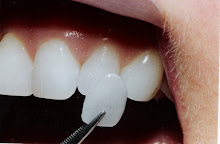As her job requires her to look good in front of the camera all the time, she cannot afford to go without a tooth.
We extracted her tooth and inserted a tiny one-tooth Flexite immediate denture.
With pink coloured nylon claps and no coverage of her palate, she was able to look good before the camera and not have a denture plate interfere with her speech immediately after her extraction.
2 months after extraction, she came in for implant surgery. The healing was not very good and the bone quality not as good as we had wanted it to be, but we managed to insert a 4.5mmx8.5mm Osstem GSII implant into the space.
 The implant is in place.
The implant is in place.The blue fixture mount was removed and the wound was stitched up.
She reported only mild discomfort after surgery and went straight back to work.
The restoration phase of the treatment will take place in 3 months.
We will post the updates then.



 2 months post-op! Our beautiful actress showed up.
2 months post-op! Our beautiful actress showed up.We relieved her of her Flexite denture, did a surgical exposure of her implant and attached an abutment to it.
Sorry, we were so excited we didn't clean up the area before taking this picture.
 After that, we placed a temporary crown over the abutment.
After that, we placed a temporary crown over the abutment.We will wait another 2 weeks for the cut gums to heal, at which time we'll take impressions for the permanent crown.
Sorry, we were so excited we didn't clean up the area before taking this picture.





























































